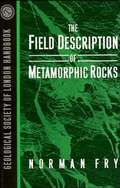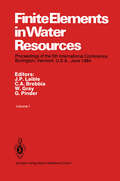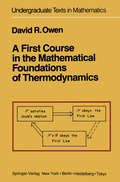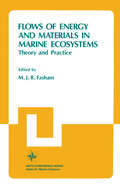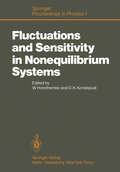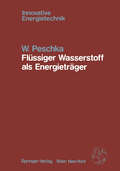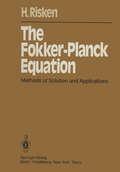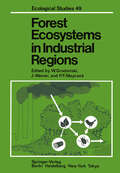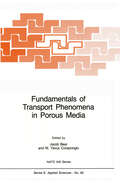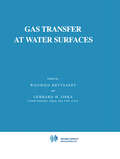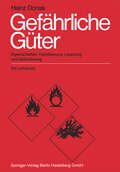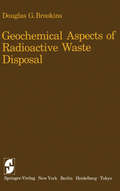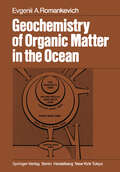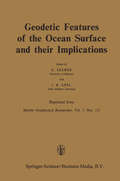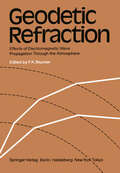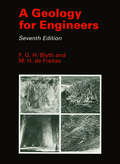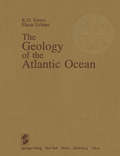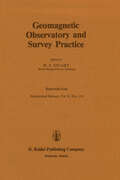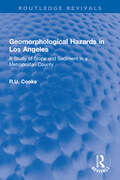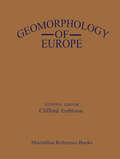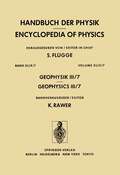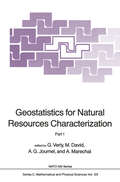- Table View
- List View
The Field Description of Metamorphic Rocks (Geological Society of London Handbook Series)
by Norman FryGeological Society of London Handbook Series Edited by KeithCox Founded in 1807, the Geological Society of London has beenpublishing since 1845 and now distributes its journal to Fellowsthroughout the world. This Handbook is published as part ofa series of authoritative practical guides to field geology. The Field Description of Metamorphic Rocks "This handbook describes how metamorphic rocks and rock masses maybe observed, recorded and mapped in the field. Written at a levelsuitable for undergraduate students of geology, this book (as withits companion volumes in the series) has firmly established itselfas an essential tool for any geologist -- student, professional oramateur -- faced with the task of making a general description ofan area of metamorphic rocks. A clear, systematic frameworktogether with numerous diagrams, illustrations and checklistsenables readers to produce useful and broadly similar descriptions,despite possible differences of background or specialist interest.This well-written and well-produced little text will, I am certain,become standard reading for most geology undergraduates. It willalso interest many geologists who do not regularly work inmetamorphic terrains and will be particularly useful to engineeringgeologists and civil engineers who are often concerned withdescribing the fabrics of metamorphic rocks without being concernedabout their origins." --M.E. Jones, Mineralogical Magazine Contents: * Metamorphic Fieldwork and Mapping * Names and Categories of Metamorphic Rocks and Rock Units * Rock Banding * Minerals * Compositions * Grade * Textures * Fabric Types * Relations to Structures * Undeformed Pods * Augen * Pseudomorphs * Veins * Igneous Contacts * Metasomatism * Reaction Zones * Fault-Zones and Mylonites * Reference Tables and Checklists
The Field Description of Metamorphic Rocks (Geological Society of London Handbook Series)
by Norman FryGeological Society of London Handbook Series Edited by KeithCox Founded in 1807, the Geological Society of London has beenpublishing since 1845 and now distributes its journal to Fellowsthroughout the world. This Handbook is published as part ofa series of authoritative practical guides to field geology. The Field Description of Metamorphic Rocks "This handbook describes how metamorphic rocks and rock masses maybe observed, recorded and mapped in the field. Written at a levelsuitable for undergraduate students of geology, this book (as withits companion volumes in the series) has firmly established itselfas an essential tool for any geologist -- student, professional oramateur -- faced with the task of making a general description ofan area of metamorphic rocks. A clear, systematic frameworktogether with numerous diagrams, illustrations and checklistsenables readers to produce useful and broadly similar descriptions,despite possible differences of background or specialist interest.This well-written and well-produced little text will, I am certain,become standard reading for most geology undergraduates. It willalso interest many geologists who do not regularly work inmetamorphic terrains and will be particularly useful to engineeringgeologists and civil engineers who are often concerned withdescribing the fabrics of metamorphic rocks without being concernedabout their origins." --M.E. Jones, Mineralogical Magazine Contents: * Metamorphic Fieldwork and Mapping * Names and Categories of Metamorphic Rocks and Rock Units * Rock Banding * Minerals * Compositions * Grade * Textures * Fabric Types * Relations to Structures * Undeformed Pods * Augen * Pseudomorphs * Veins * Igneous Contacts * Metasomatism * Reaction Zones * Fault-Zones and Mylonites * Reference Tables and Checklists
Finite Elements in Water Resources: Proceedings of the 5th International Conference, Burlington, Vermont, U.S.A., June 1984
by J. P. Laible C. A. Brebbia W. Gray G. PinderThis book is the edited proceedings of the Fifth International Conference on Finite Elements in Water Resources, held at the University of Vermont, USA in June 1984. This Conference cont inues the successful series started at Princeton University in 1976, followed by the Conference in Imperial College, London, UK in 1978, the third Conference at the University of Mississippi, USA in 1980 and the fourth at the University of Hannover, Germany in 1982. The objective of this Conference is to provide engineers and scientists interested in water resources with the state-of-t- art on finite element modelling. The Proceedings review the basic theory and applications of the technique in groundwater and seepage, transport phenomena, viscous flow, river, lake and ocean modelling. The fundamentals of the numerical techniques employed in finite elements are also discussed. Many applications illus trate the versatility and generality of the Finite Element Method for the simulation of a wide range of problems in water resources. More recent schemes, in particular, boundary elements, are also presented, together with a series of advanced numerical techniques. The Conference has become an internationally accepted forum for the presentation of new developments of finite elements in water resources techniques. Because of this, a large number of abstracts were submitted to the Organizing Committee and it is our only reg ret that it was impossible to accept all these contributions. The overwhelming response to our Call for Papers has ensured the high quality of these proceedings.
A First Course in the Mathematical Foundations of Thermodynamics (Undergraduate Texts in Mathematics)
by D.R. OwenResearch in the past thirty years on the foundations of thermodynamics has led not only to a better understanding of the early developments of the subject but also to formulations of the First and Second Laws that permit both a rigorous analysis of the consequences of these laws and a substantial broadening of the class of systems to which the laws can fruitfully be applied. Moreover, modem formulations of the laws of thermodynamics have now achieved logically parallel forms at a level accessible to under graduate students in science and engineering who have completed the standard calculus sequence and who wish to understand the role which mathematics can play in scientific inquiry. My goal in writing this book is to make some of the modem develop ments in thermodyamics available to readers with the background and orientation just mentioned and to present this material in the form of a text suitable for a one-semester junior-level course. Most of this presentation is taken from notes that I assembled while teaching such a course on two occasions. I found that, aside from a brief review of line integrals and exact differentials in two dimensions and a short discussion of infima and suprema of sets of real numbers, juniors (and even some mature sophomores) had sufficient mathematical background to handle the subject matter. Many of the students whom I taught had very limited experience with formal and rigorous mathematical exposition.
Flows of Energy and Materials in Marine Ecosystems: Theory and Practice (Nato Conference Series #13)
by M. J. FashamThe impetus for the conference held at Bombannes, France in May, 1982 arose out of a Scientific Committee on Oceanic Research (SCOR) Working Group on "Mathematical Models in Biological Oceanography". This group was chaired by K.H. Mann and held two meetings in 1977 and 1979. At both meetings it was felt that, although reductionist modelling of marine ecosystems had achieved some successes, the future progress lay in the development of holistic ecosystem models. The members of the group (K.H. Mann, T. Platt, J.M. Colebrook, D.F. Smith, M.J.R. Fasham, J. Field, G. Radach, R.E. Ulanowicz and F. Wulff) produced a critical review of reductionist and holistic models which was published by the Unesco Press (Platt, Mann and Ulanowicz, 1981). One of the conclusions of this review was that, whether holistic or reductionist models are preferred, it is critically important to increase the scientific effort in the measurement of physiological rates for the computation of ecological fluxes. The Working Group therefore recommended that an international meeting should be organized which would attempt to bring together theoretical ecologists and biological oceanographers to assess the present and future capability for measuring ecological fluxes and incorporating these data into models. An approach was made to the Marine Sciences Panel of the NATO Science Committee who expressed an interest in funding such a meeting. They awarded a planning grant and a planning group was formed consisting of M.J.R. Fasham, M.V. Angel, T. Platt, R.E.
Fluctuations and Sensitivity in Nonequilibrium Systems: Proceedings of an International Conference, University of Texas, Austin, Texas, March 12–16, 1984 (Springer Proceedings in Physics #1)
by W. Horsthemke D. K. KondepudiFlüssiger Wasserstoff als Energieträger: Technologie und Anwendungen (Innovative Energietechnik)
by W. PeschkaThe Fokker-Planck Equation: Methods of Solution and Applications (Springer Series in Synergetics #18)
by Hannes RiskenOne of the central problems synergetics is concerned with consists in the study of macroscopic qualitative changes of systems belonging to various disciplines such as physics, chemistry, or electrical engineering. When such transitions from one state to another take place, fluctuations, i.e., random processes, may play an im portant role. Over the past decades it has turned out that the Fokker-Planck equation pro vides a powerful tool with which the effects of fluctuations close to transition points can be adequately treated and that the approaches based on the Fokker Planck equation are superior to other approaches, e.g., based on Langevin equa tions. Quite generally, the Fokker-Planck equation plays an important role in problems which involve noise, e.g., in electrical circuits. For these reasons I am sure that this book will find a broad audience. It pro vides the reader with a sound basis for the study of the Fokker-Planck equation and gives an excellent survey of the methods of its solution. The author of this book, Hannes Risken, has made substantial contributions to the development and application of such methods, e.g., to laser physics, diffusion in periodic potentials, and other problems. Therefore this book is written by an experienced practitioner, who has had in mind explicit applications to important problems in the natural sciences and electrical engineering.
Forest Ecosystems in Industrial Regions: Studies on the Cycling of Energy Nutrients and Pollutants in the Niepo?omice Forest Southern Poland (Ecological Studies #49)
by W. Grodzinski J Weiner P. MaycockA number of well-known forests have been the object of studies by ecological teams. Every ecologist is familiar with the names of forests such as Whytham Woods in England (Elton 1966), Solling in West Germany (Ellenberg 1971), Hubbard Brook in New Hampshire, U. S. A. (Likens et al. 1977, Bormann and Likens 1979), and ladra6s in Central Sweden (Persson 1980). The number of such team studies grew rapidly during the period of the International Biological Programme (Reichle 1981). Each of these forests represented aspects oflocal and general interest. The Niepolomice Forest in Southern Poland (Fig. 1) does not possess any spectacular features and it may be regarded as a typical forest of the lowlands of continental Europe. Situated in the Vistula River Valley, 20 km east of Cracow (50°07' N, 20°23' E) it consists of two major sections: an extensive pine forest of the Pino-Quercetum type, and a smaller, deciduous, oak-hornbeam- Fig. 1. The location of the Niepolomice Forest in Southern Poland VI Preface Tilio Carpinetum forest. This huge forested area (11,000 ha) owes its survival in one of the most densely populated parts of Europe to a long period of protection as a royal hunting ground. The period of royal protection ended abruptly at the turn of 20th century under the devastating blows of two world wars followed by perhaps an even greater danger, the effects of modern developments in heavy industry.
Fundamentals of Transport Phenomena in Porous Media (NATO Science Series E: #82)
by Jacob Bear M. Y. CorapciogluThis volume contains the lectures presented at the NATO Advanced Study Institute that took place at the University of Delaware, Newark, Delaware, July 18-27, 1982. The purpose of this Institute was to provide an international forum for exchange of ideas and dissemination of knowledge on some selected topics in Mechanics of Fluids in Porous Media. Processes of transport of such extensive quantities as mass of a phase, mass of a component of a phase, momentum and/or heat occur in diversified fields, such as petroleum reservoir engineer ing, groundwater hydraulics, soil mechanics, industrial filtration, water purification, wastewater treatment, soil drainage and irri gation, and geothermal energy production. In all these areas, scientists, engineers and planners make use of mathematical models that describe the relevant transport processes that occur within porous medium domains, and enable the forecasting of the future state of the latter in response to planned activities. The mathe matical models, in turn, are based on the understanding of phenomena, often within the void space, and on theories that re late these phenomena to measurable quantities. Because of the pressing needs in areas of practical interest, such as the develop ment of groundwater resources, the control and abatement of groundwater contamination, underground energy storage and geo thermal energy production, a vast amount of research efforts in all these fields has contributed, especially in the last t~o decades, to our understanding and ability to describe transport phenomena.
Gas Transfer at Water Surfaces (Water Science and Technology Library #2)
by Wilfried Brutsaert Gerhard H. JirkaThe transfer across the surface of environmental waters is of interest as an important phase in the geophysical and natural biochemical cycles of numer ous substances; indeed it governs the transition, one way or the other, be tween the dissolved state in the water and the gaseous state in the atmo sphere. Especially with increasing population and industrialization, gas transfer at water surfaces has become a critical factor in the understanding of the various pathways of wastes in the environment and of their engineering management. This interfacial mass transfer is, by its very nature, highly complex. The air and the water are usually in turbulent motion, and the interface be tween them is irregular, and disturbed by waves, sometimes accompanied by breaking, spray and bubble formation. Thus the transfer involves a wide variety of physical phenomena occurring over a wide range of scales. As a consequence, scientists and engineers from diverse disciplines and problem areas, have approached the problem, often with greatly differing analytical and experimental techniques and methodologies.
Geochemical Aspects of Radioactive Waste Disposal
by D. G. BrookinsThere is an extremely voluminous literature on radioactive waste and its disposal, much in the form of government-sponsored research reports. To wade through this mountain of literature is indeed a tedious task, and it is safe to speculate that very few, if any, individuals have the time to examine each report that has been issued during the preceding ten years. This book attempts to summarize much of this literature. Further, many workers in the geosciences have not received training in the nuclear sciences, and many nuclear scientists could be better versed in geology. In this book an attempt is made to cover some background material on radioactive wastes and geotoxicity that may not be an integral part of a geologist's training, and background material on geology and geochemistry for the nuclear scientist. The geochemical material is designed for both the geoscientist and the nuclear scientist. There is no specific level for this book. Certainly, it should be useful to advanced undergraduates and graduates studying geology and nuclear science. It does not pretend to cover a tremendous amount of detail in all subjects, yet the references cited provide the necessary source materials for follow-up study. It is my intention that the reader of this book will have a better, broader understanding of the geochemical aspects of radioactive waste disposal than is otherwise available in anyone source.
Geochemistry of Organic Matter in the Ocean
by Evgenii A. RomankevichMy work Geochemistry oj organic matter in the ocean first appeared in Russian in 1978. Since then much progress has been made in the exploration of various forms of organic matter in the ocean: dissolved, colloidal, organic matter sus pended in particles and that contained in bottom sediments and in interstitial waters. The appropriate evidence is found in hundreds of articles and several re view works, such as Andersen (1977), Biogeochimie de [a matiere organique a ['interjace eau-sedimentmarine (1980), Duursma and Dawson (1981). A great amount of new information has been obtained in the Soviet Union's scientific institutions on the composition and distribution in natural waters and bottom sediments of organic matter and its separate components playing a crucial role in the formation of the chemical and biological structure of the ocean and its productivity, in the biogeochemistry of the elements and geochemistry of organic matter in the Earth's sedimentary cover. The areas of exploration have expanded over the past four-and-a-half years to embrace many new, little-known regions, including the Arctic seas. In contrast to the three preceeding decades, the research has been focused on investigating the existing forms, the distribution and accumulation of organic matter in near continental oceanic zones between land and sea, and in river estuaries.
Geodetic Features of the Ocean Surface and their Implications
by G. Seeber J. R. ApelThis volume contains most of the papers which were presented at the Interdisciplinary Symposium No. 4 "Geodetic Features of the Ocean Surface and their Implications" during the XVIII. General Assembly of the International Union of Geodesy and Geophysics (IUGG) in Hamburg, August 1983. The symposium was jointly sponsored by the International Associ ation of Geodesy (lAG) and the International Association for the Physi cal Sciences of the Ocean (IAPSO), and was as such one further step in animpQrtant line of international and interdisciplinary symposia, re lated to the field of Marine Geodesy. Originally the term "Marine Geodesy" was widely understood as "Geodesy in the Marine Environment" and dealt primarily with two as pects: precise position determination at sea and determination of a fine structured marine geoid. However, mainly with the impact of satel lite radar altimeter measurements, a new understanding began to develop: it became evident that the field of Marine Geodesy could not be treated adequately from geodesists alone but that it needed close cooperation with related disciplines such as oceanography and marine geophysics. Symposium No. 4 at Hamburg could demonstrate that this coopera tion has already become a lively reality. The "geodetic features of the ocean surface" don't only reflect oceanographical but also marine geo physical aspects. As such scientists from geodesy, oceanography, marine geology and geophysics came together to present their ideas and to dis cuss questions of mutual interest.
Geodetic Refraction: Effects of Electromagnetic Wave Propagation Through the Atmosphere
by F. K. BrunnerWith very few exceptions, geodetic measurements use electro magnetic radiation in order to measure directions, distances, time delays, and Doppler frequency shifts, to name the main ter restrial and space observables. Depending on the wavelength of the radiation and the purpose of the measurements, the follow ing parameters of the electromagnetic wave are measured: ampli tude, phase, angle-of-arrival, polarisation and frequency. Ac curate corrections have to be applied to the measurements in order to take into account the effects of the intervening medium between transmitter and receiver. The known solutions use at mospheric models, special observation programs, remote sensing techniques and instrumental methods. It has been shown that the effects of the earth's atmospheric envelope present a fundamental limitation to the accuracy and precision of geodetic measurements. This applies equally to ter restrial and space applications. Instrumental accuracies are al ready below the atmospherically induced limitations, and thus the accuracy demands on the geodetic refraction solutions are entering a new magnitude zone. This monograph is primarily devoted to the properties of the at mospheric effects on various geodetic measurements and to their evaluation. Ten review papers cover the most pressing aspects of the atmospheric effects on geodetic measurement~. Ttiese state of-the art papers were written by eminent specialists in their respective research fields.
A Geology for Engineers
by F.G.H. Blyth Michael de FreitasNo engineering structure can be built on the ground or within it without the influence of geology being experienced by the engineer. Yet geology is an ancillary subject to students of engineering and it is therefore essential that their training is supported by a concise, reliable and usable text on geology and its relationship to engineering. In this book all the fundamental aspects of geology are described and explained, but within the limits thought suitable for engineers. It describes the structure of the earth and the operation of its internal processes, together with the geological processes that shape the earth and produce its rocks and soils. It also details the commonly occurring types of rock and soil, and many types of geological structure and geological maps. Care has been taken to focus on the relationship between geology and geomechanics, so emphasis has been placed on the geological processes that bear directly upon the composition, structure and mechanics of soil and rocks, and on the movement of groundwater. The descriptions of geological processes and their products are used as the basis for explaining why it is important to investigate the ground, and to show how the investigations may be conducted at ground level and underground. Specific instruction is provided on the relationship between geology and many common activities undertaken when engineering in rock and soil.
A Geology for Engineers, Seventh Edition
by F.G.H. Blyth Michael De FreitasNo engineering structure can be built on the ground or within it without the influence of geology being experienced by the engineer. Yet geology is an ancillary subject to students of engineering and it is therefore essential that their training is supported by a concise, reliable and usable text on geology and its relationship to engineering. In this book all the fundamental aspects of geology are described and explained, but within the limits thought suitable for engineers. It describes the structure of the earth and the operation of its internal processes, together with the geological processes that shape the earth and produce its rocks and soils. It also details the commonly occurring types of rock and soil, and many types of geological structure and geological maps. Care has been taken to focus on the relationship between geology and geomechanics, so emphasis has been placed on the geological processes that bear directly upon the composition, structure and mechanics of soil and rocks, and on the movement of groundwater. The descriptions of geological processes and their products are used as the basis for explaining why it is important to investigate the ground, and to show how the investigations may be conducted at ground level and underground. Specific instruction is provided on the relationship between geology and many common activities undertaken when engineering in rock and soil.
The Geology of the Atlantic Ocean
by Kenneth O. Emery Elazar UchupiThe explosion of interest, effort, and information about the ocean since about 1950 has produced many thousand scientific articles and many hun dred books. In fact, the outpouring has been so large that authors have been unable to read much of what has been published, so they have tended to concentrate their own work within smaller and smaller subfields of oceanog raphy. Summaries of information published in books have taken two main paths. One is the grouping of separately authored chapters into symposia type books, with their inevitable overlaps and gaps between chapters. The other is production of lightly researched books containing drawings and tables from previous pUblications, with due credit given but showing assem bly-line writing with little penetration of the unknown. Only a few books have combined new and previous data and thoughts into new maps and syntheses that relate the contributions of observed biological, chemical, geological, and physical processes to solve broad problems associated with the shape, composition, and history of the oceans. Such a broad synthesis is the objective of this book, in which we tried to bring together many of the pieces of research that were deemed to be of manageable size by their originators. The composite may form a sort of plateau above which later studies can rise, possibly benefited by our assem bly of data in the form of new maps and figures.
Geomagnetic Observatory and Survey Practice
by W. F. StuartThis issue is a collection of the papers read at the 'Workshop on Geomagnetic Observatory and Survey Practice' held during the XIVth General Assembly of IUGG (the International Union of Geology and Geophysics) in Hamburg, August 1983, sponsored by Division V of the International Association of Geomagnetism and Aeronomy (IAGA). The papers represent a snapshot taken at a very important time in the history of Geomagnetism and of the sciences which depend on measurements of one kind or another of the Earth's magnetic field. Research science now demands a much greater amount of information to be prepared and immediately made available to the scientific user. Experimental measurements are now required to be reduced, selected and made ready as information which can be recorded as data on magnetic tape in the form required for direct incorporation into the analytical programmes whiCh individual researchers run on digital computers. Computing has reduced the lead time between when observations are made and when they are required by researchers. Many scientific programmes, particularly those related to Solar-terrestrial geophysics, need data to be analysed as near as possible to the time it is recorded. In Geomagnetism these pressures apply to field variations where satellite based geophysical experiments require high resolution of the fine structure of external disturbance fields, and also to field mapping on a global and local scale where the demand for increased accuracy calls for better absolute observations and more frequent surveys.
Geomorphological Hazards in Los Angeles: A Study of Slope and Sediment in a Metropolitan County (Routledge Revivals)
by R.U. CookeThis book, first published in 1984, deals authoritatively with the nature and management of slope failures and sediment movement and their impact on the hazardous landscape of Los Angeles county. Bringing together for the first time a wide range of information derived from field observations, interviews, manuscript records, local agency reports and published sources, the book presents an analysis of the ways in which a rapidly developing metropolis has come to terms with complex geomorphological hazards. In particular, the events accompanying the major storms of 1914, 1934, 1969 and 1978 are reconstructed in detail.
Geomorphological Hazards in Los Angeles: A Study of Slope and Sediment in a Metropolitan County (Routledge Revivals)
by R.U. CookeThis book, first published in 1984, deals authoritatively with the nature and management of slope failures and sediment movement and their impact on the hazardous landscape of Los Angeles county. Bringing together for the first time a wide range of information derived from field observations, interviews, manuscript records, local agency reports and published sources, the book presents an analysis of the ways in which a rapidly developing metropolis has come to terms with complex geomorphological hazards. In particular, the events accompanying the major storms of 1914, 1934, 1969 and 1978 are reconstructed in detail.
Geophysik III / Geophysics III (Handbuch der Physik Encyclopedia of Physics #10 / 49 / 7)
by G. Schmidtke K. Suchy K. RawerThis Encyclopedia aims, basically, at summanzmg the wealth of well established facts and outlining the relevant theories in the different branches of physics. With this as goal, the writers were asked to present their specific field in such a way that access is possible to any scientist without special a priori information in that field; the basic concepts of physics are assumed to be known to the reader. The survey given in each paper was also to be long lasting, so that even a few years after publication, each volume would be useful, for example as an introduction for newcomers or as a source of information for workers in a neighbouring field. In the field of geophysics, dealt with in Vols. 47--49 of the Encyclopedia, this task is difficult to achieve because during the last decades there has been a much faster development of basic information and theory than during the decades before. When I came to contribute to this work the famous Julius Bartels, then editor of the geophysical part, told me that Vol. 49 should certainly take into account the results of the "International Geophysical Year" 1957/58 (I. G. Y. ), and that we had better wait until these were accessible than produce a kind of information which might be obsolete in a short time.
